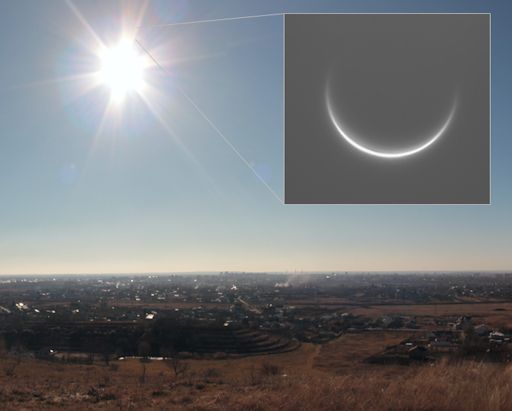CHANCE OF FLARES: NOAA forecasters estimate a 35% chance of X-class solar flares on Jan. 11th, most likely from AR1944. The brooding sunspot has been quiet for days, but still poses a threat for strong eruptions. Solar flare alerts: text, voice.
VENUS AT INFERIOR CONJUNCTION: Today, Jan. 11th, Venus is at inferior conjunction. That means it is passing almost directly between Earth and the sun. With its nightside facing Earth (almost perfectly), Venus looks like an incredibly slender crescent. This morning in Targoviste, Romania, amateur astronomer Maximilian Teodorescu photographed Venus only 5 degrees from the sun:
"Taking extreme care not to point any unfiltered optics at the sun, I started to look for Venus through my 11-inch Celestron telescope," says Teodorescu. "The thin but very large crescent suddenly appeared into the field of view. It was surreal to watch the boiling atmospheric arc of the planet just above the sun in plain day. My wife immortalized the moment by taking a panoramic view from our clear-sky location."
Observing Venus through a telescope can be dangerous. Even a quick inadvertent glimpse of magnified light from the nearby sun can cause serious eye damage. Anthony J. Cook of the Griffith Observatory has some advice for observers: "I have observed Venus at conjunction, but only from within the shadow of a building, or by adding a mask to the front end of the telescope to fully shadow the optics from direct sunlight. This is tricky with a refractor or a catadioptric, because the optics start at the front end of the tube. Here at Griffith Observatory, I rotate the telescope dome to make sure the lens of the telescope is shaded from direct sunlight, even through it means that the lens will be partially blocked when aimed at Venus. With our Newtonian telescope, I add a curved cardboard mask at the front end of the tube to shadow the primary mirror."
Around the world, many people are applying these techniques to photograph Venus as it passes by the sun. Browse the gallery to see their amazing results:

Solar wind
speed: 397.3 km/sec
density: 0.5 protons/cm3
explanation | more data
Updated: Today at 2116 UT
X-ray Solar Flares
6-hr max: C1 2046 UT Jan11
24-hr: C6 1310 UT Jan11
explanation | more data
Updated: Today at: 2100 UT
![]()
Daily Sun: 11 Jan 14
Sunspot AR1944 has a 'beta-gamma-delta' magnetic field that harbors energy for X-class solar flares. Credit: SDO/HMI
![]()
Sunspot number: 138
What is the sunspot number?
Updated 11 Jan 2014
Spotless Days
Current Stretch: 0 days
2014 total: 0 days (0%)
2013 total: 0 days (0%)
2012 total: 0 days (0%)
2011 total: 2 days (<1%)
2010 total: 51 days (14%)
2009 total: 260 days (71%)
Update 11 Jan 2014
The Radio Sun
10.7 cm flux: 175 sfu
explanation | more data
Updated 11 Jan 2014
![]()
Current Auroral Oval:
Switch to: Europe, USA, New Zealand, Antarctica
Credit: NOAA/POES
![]()
Planetary K-index
Now: Kp= 3 quiet
24-hr max: Kp= 3 quiet
explanation | more data
Interplanetary Mag. Field
Btotal: 7.2 nT
Bz: 5.8 nT north
explanation | more data
Updated: Today at 2117 UT
![]()
Coronal Holes: 11 Jan 14
Solar wind flowing from this emerging coronal hole should reach Earth on Jan. 13-15. Credit: SDO/AIA.





